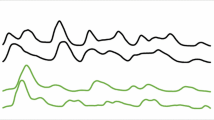Abstract
This paper proposes threshold models to analyze and forecast interval-valued time series. A relatively simple algorithm is proposed to obtain least square estimates of the threshold and slope parameters. The construction of forecasts based on the proposed model and methods for the analysis of their forecast performance are also introduced and discussed, as well as forecasting procedures based on the combination of different models. To illustrate the usefulness of the proposed methods, an empirical application on a weekly sample of S&P500 index returns is provided. The results obtained are encouraging and compare very favorably to available procedures.


Similar content being viewed by others
Notes
Note that it is not clear if the results obtained in the following sections will hold for the lower-upper bound representation of ITS, and we do not pursue this extension in this paper. However, this presents an interesting line of research for further investigation.
Following the suggestion of one referee, to compare predictive accuracy we have also conducted Diebold–Mariano tests (see Appendix) and the results obtained corroborate these conclusions.
References
Arroyo J, Maté C (2006) Introducing interval time series: accuracy measures. COMPSTAT 2006. Proceeding in Computational statistics, Heidelberg, pp 1139–1146
Arroyo J, Espínola R, Maté C (2011) Different approaches to forecast interval time series: a comparison in finance. Comput Econ 37:169–191
Arroyo J, Gonzalez-Rivera G, Maté C (2010) Forecasting with Interval and Histogram Data. Some Financial Applications. In: Ullah A, Giles D (eds.) Handbook of Empirical Economics and Finance, Chapman and Hall, pp 247–280
Bai J (1997) Estimating multiple breaks one at a time. Econ Theory 13:315–352
Beckers S (1983) Variance of security price return based on high, low and closing prices. J Bus 56:97–112
Cheung YW (2007) An empirical model of daily highs and lows. Int J Financ Econ 12:1–20
Chou RY (2005) Forecasting financial volatilities with extreme values: the conditional autoregressive range (CARR) model. J Money Credit Bak 37(3):561–582
Clements MP, Smith J (1999) A monte carlo study of the forecasting performance of empirical SETAR models. J Appl Econ 14(2):123–141
Diebold F, Mariano R (1995) Comparing predictive accuracy. J Bus Econ Statistics 13(3):253–263
Dueker M, Martin S, Spangnolo F (2007) Contemporaneous threshold autoregressive models: estimation, testing and forecasting. J Econ 141:517–547
Eitrheim Ã, Teräsvirta T (1996) Testing the adequacy of smooth transition autoregressive models. J Econ 74:59–75
Gonzalo J, Pitarakis J-Y (2002) Estimation and model selection based inference in single and multiple threshold models. J Econ 110:319–352
Granger CWJ, Terasvirta T (1993) Modelling non-linear economic relationships. OUP Catalogue. Oxford University Press. ISBN 9780198773207
Guidolin M, Hyde S, McMillan D, Ono S (2009) Non-linear predictability in stock and bond returns: when and where is it exploitable? Int J Forecast 25:373–399
Hansen B (1996) Inference when a nuisance parameter is not identified under the null hypothesis. Econometrica 64:413–430
Hansen B (1997) Inference in TAR models. Studies in Nonlinear Dynamics and Econometrics 2
Henry Ó, Olekaln N, Summers PM (2001) Exchange rate instability: a threshold autoregressive approach. Econ Record 77:160–166
Hu C, He LT (2007) An application of interval methods to stock market forecasting. Reliab Comput 13(5):423–434
Hsu HL, Wu B (2008) Evaluating forecasting performance for interval data. Comput Math Appl 56:2155–2163
Ichino M, Yaguchi H (1994) Generalized Minkowski metrics for mixed and feature-type data analysis. IEEE Trans Systems Man Cybern 24(1):698–708
Maia ALS, de Carvalho FdAT (2011) Holt’s exponential smoothing and neural network models for forecasting interval-valued time series. Int J Forecast 27:740–759
Muñoz SR, Maté AC, Arroyo J, Sarabia Á (2007) iMLP: Applying multi-layer perceptrons to interval-valued data. Neural Process Lett 25:157–169
Nieto FH (2005) Modelling bivariate threshold autoregressive processes in the presence of missing data. Commun Stat Theory Methods 34:905–930
Pitarakis J-Y (2006) Model selection uncertainty and detection of threshold effects. Studies in Nonlinear Dynamics and Econometrics 10
Timmermann A (2006) Forecast Combinations. Handbook of Economic Forecasting, Elsevier, Amsterdam
Tong H (2011) Threshold models in time series analysis â 30 years on (with discussions by P. Whittle, M. Rosenblatt, B. E. Hansen, P. Brockwell, N. I. Samia and F. Battaglia). Stat Interface 4:107–136
Tsay RS (1998) Testing and modelling multivariate threshold models. J Am Stat Assoc 93:1188–1202
Zhang G (2003) Time series forecasting using a hybrid ARIMA and neural network model. Neurocomputing 50:159–175
Zou H, Yang Y (2004) Combining time series models for forecasting. Int J Forecast 20:69–84
Acknowledgments
We are grateful to the participants of the ISF 2010 conference in San Diego and the SDA Workshop 2012 in Madrid for useful comments and suggestions. We would also like to thank Guest Editor Dr. Javier Arroyo, Coordinating Editor Professor Maurizio Vichi and three anonymous referees for helpful and constructive comments on an earlier version of this paper.
Author information
Authors and Affiliations
Corresponding author
Appendix: Diebold–Mariano predictive accuracy tests
Appendix: Diebold–Mariano predictive accuracy tests
Table 4 provides Diebold and Mariano (1995) test results for the comparison of different forecast methods. The results in this table are for center and radius forecasts and are based on loss differentials which are defined as the difference of squared forecast errors.
Rights and permissions
About this article
Cite this article
Rodrigues, P.M.M., Salish, N. Modeling and forecasting interval time series with threshold models. Adv Data Anal Classif 9, 41–57 (2015). https://doi.org/10.1007/s11634-014-0170-x
Received:
Revised:
Accepted:
Published:
Issue Date:
DOI: https://doi.org/10.1007/s11634-014-0170-x




